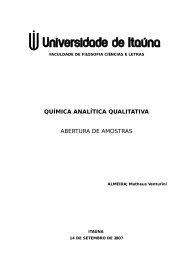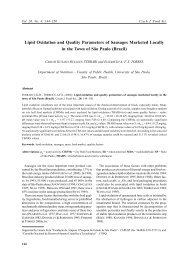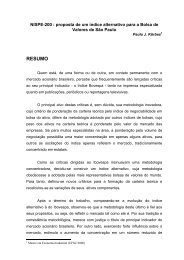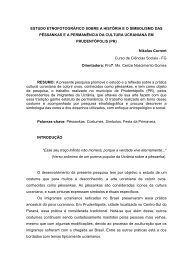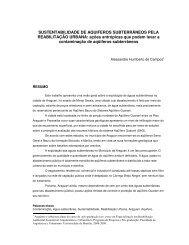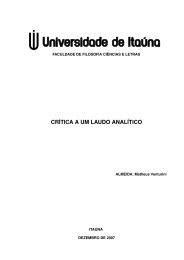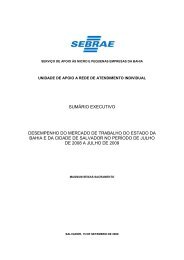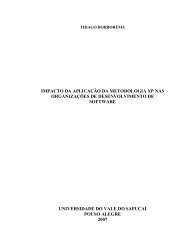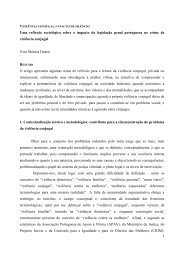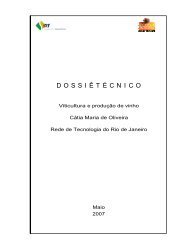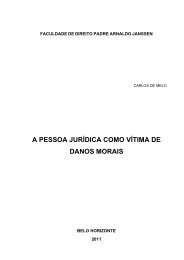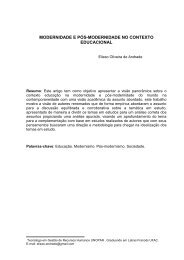MAL 007
MAL 007
MAL 007
You also want an ePaper? Increase the reach of your titles
YUMPU automatically turns print PDFs into web optimized ePapers that Google loves.
M.B.B. Leal et al.<br />
Figure 4. Dissolved oxygen in the medium (O2) and colony<br />
forming units (CFU) as a function of cultivation time.<br />
therefore, corresponds to the cultivation harvest time and<br />
consequently to a highly immunogenic BCG.<br />
The results in Table 2 show that the lowest initial glycerol<br />
and the highest L-asparagine concentrations implied the<br />
maximum dry biomass productivity (runs 8 and 9, PMx=2.50 g/<br />
day), but not the maximum CFU productivity (runs 12 and 13,<br />
PCFU=2.68⋅10 6 CFU/mg.day).<br />
Moreover, concerning relative consumption of substrates,<br />
shown in figures 1 to 3, it is possible to estimate the averages of<br />
global yield factors (YX/G=0.14 and YX/N=5.25 respectively),<br />
which led to an average relation (carbon/nitrogen) namely C/N<br />
≅16 (w/w). The maximum variation coefficient for these<br />
calculated averages was 30.0%.<br />
342<br />
DISCUSSION<br />
This microorganism generally grows as a surface veil in nonagitated<br />
culture flasks. In Instituto Butantan, the BCG lyophilized<br />
vaccine is supplied in vials with 10 doses, containing 1 mg of<br />
BCG lyophilized and between 2 to 10 million of live bacilli each.<br />
The production is 70,000 vials or 700,000 doses. For this purpose,<br />
96 L of Sauton medium are prepared weekly and distributed in<br />
aliquots of 80 mL (in flasks of 300 mL), totaling 1,200 flasks for the<br />
static cultivation of Mycobacterium bovis BCG (19). This<br />
represents an approximated concentration of 0.7 g of bacteria per<br />
liter of medium. In the present work higher values of dry biomass<br />
productivity and CFU productivity are obtained (Table 2). These<br />
data are truly promising regarding process transposition from<br />
static to submerged cultivation in bioreactors.<br />
The increase of the BCG production is a public necessity<br />
considering it is the most widely used vaccine in the world against<br />
tuberculosis. Besides this, it is a useful vaccine for delivering<br />
protective antigens of multiple pathogens (20). Since the early<br />
90s the BCG has been studied for this purpose because of its<br />
unique characteristics, including low toxicity adjuvant potential<br />
and long-lasting immunity (21). These recombinant BCG strains<br />
can elicit long-lasting humoral and cellular immune responses to<br />
foreign antigens (22). Several studies were done with this<br />
approach for developing vaccines against diverse diseases: AIDS<br />
(23), hepatitis C (24), leishmaniosis (25) and several others. In<br />
accordance with this approach, Instituto Butantan recently<br />
developed a recombinant Mycobacterium bovis BCG expressing<br />
the Sm14 antigen of Schistosoma mansoni which protected mice<br />
submitted to cercarial challenge tests (26). Also, it is remarkable<br />
that in Instituto Butantan there is another research line studying<br />
the use of recombinant proteins for developing a vaccine against<br />
tuberculosis which is more potent than the classical one (27).<br />
However, very little data are found in the literature related to<br />
suitable BCG process production in bioreactors. A suitable small<br />
scale cultivation in the bioreactor has been recently described<br />
(28). It was performed in a 3 L total capacity vessel, employing<br />
2 L of Sauton medium, at a cultivation temperature of 37ºC,<br />
dissolved oxygen controlled above 20% saturation and agitation<br />
frequency varying from 360 to 500 rpm. The microorganism was<br />
M. bovis - BCG (Copenhagen strain) cultivated for 164 hs (6<br />
days and 20 h). The maximum cell concentration achieved was<br />
equivalent to an optical density (measured at 600 nm) of 2.2<br />
units and a CFU value of 1.02⋅10 9 /mL. According to that report,<br />
the bioreactor-grown BCG bacteria exhibited a similar vaccine<br />
efficacy against a challenge (in tests with mice) with M.<br />
tuberculosis with regard to the BCG obtained from the classical<br />
surface-grown culture. Thus, through those biological tests,<br />
the real possibility of process transposition from static to<br />
submerged cultivation in bioreactors was proven. However, still<br />
considering the great importance of the information contained<br />
in that paper, their focus was not on showing a clear growth<br />
curve, neither a clear dissolved oxygen variation in the medium.<br />
Furthermore, a kinetic study of carbon and nitrogen source<br />
consumptions was not presented.<br />
For scale-up bioreactor cultivations, besides the c-GMP<br />
norms, which recommend the use of chemically, defined medium<br />
(29), the use of an optimized cultivation medium is advisable for<br />
economic reasons. Thus, the present study describes, in a larger<br />
scale, the preliminary kinetic analysis in order to contribute to<br />
the search of such optimization.<br />
In the present work, slow bacterial growth (average of µmax<br />
= 0.35 day -1 - runs 6 to 13) was observed, even in the bioreactor<br />
(Fig. 1) where the agitation is very efficient. The slow growth of<br />
many mycobacteria is probably due to the hydrophobic<br />
character of the cellular wall surface, which makes the transport<br />
of the nutrients through the bacterial cell membrane difficult<br />
(30). On the other hand, being the high lipid content a<br />
characteristic of the mycobacteria (constituting 60% of the



